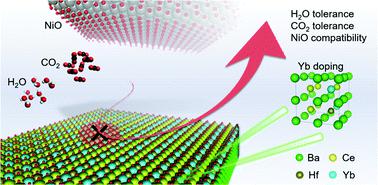当前位置:
X-MOL 学术
›
Energy Environ. Sci.
›
论文详情
Our official English website, www.x-mol.net, welcomes your
feedback! (Note: you will need to create a separate account there.)
Critical role of acceptor dopants in designing highly stable and compatible proton-conducting electrolytes for reversible solid oxide cells
Energy & Environmental Science ( IF 32.4 ) Pub Date : 2022-05-31 , DOI: 10.1039/d2ee01104b Zheyu Luo 1 , Yucun Zhou 1 , Xueyu Hu 1 , Nichloas Kane 1 , Tongtong Li 1 , Weilin Zhang 1 , Zhijun Liu 1 , Yong Ding 1 , Ying Liu 2 , Meilin Liu 1
Energy & Environmental Science ( IF 32.4 ) Pub Date : 2022-05-31 , DOI: 10.1039/d2ee01104b Zheyu Luo 1 , Yucun Zhou 1 , Xueyu Hu 1 , Nichloas Kane 1 , Tongtong Li 1 , Weilin Zhang 1 , Zhijun Liu 1 , Yong Ding 1 , Ying Liu 2 , Meilin Liu 1
Affiliation

|
Proton-conducting electrolytes are receiving increasing attention due to their high ionic conductivity at intermediate temperatures, enabling the operation of solid oxide cells with high energy efficiency at low cost. However, the effect of B-site dopants on the properties of doped barium hafnate-cerate electrolyte materials, especially in single cells under operating conditions, has not been systematically studied. Here we report our findings in the development of a series of proton-conducting electrolytes with a general formula of BaHf0.1Ce0.7R0.2O3−δ (BHCR172, R = Yb, Er, Y, Gd, Sm). The results reveal that electrical conductivity, ionic transference number, chemical stability against steam and CO2, and compatibility with NiO during sintering are all closely correlated with the dopant size. In particular, the reaction with NiO is found to strongly affect the properties of the electrolytes and hence cell performance. Among all tested compositions, BaHf0.1Ce0.7Yb0.2O3−δ (BHCYb172) shows excellent chemical stability and minimal reactivity towards NiO, as predicted from density functional theory (DFT)-based calculations and confirmed by experimental results. In addition, proton-conducting reversible solid oxide cells (P-ReSOCs) based on the optimized electrolyte composition, BHCYb172, demonstrate exceptional performance and stability, achieving a remarkable peak power density of 1.74 W cm−2 (O2 as the oxidant) at 600 °C in the fuel cell mode and a high current density of 2.0 A cm−2 at 1.3 V and 600 °C in the steam electrolysis mode while maintaining excellent durability for over 1000 h.
中文翻译:

受体掺杂剂在为可逆固体氧化物电池设计高度稳定和兼容的质子传导电解质中的关键作用
质子传导电解质因其在中等温度下的高离子电导率而受到越来越多的关注,从而能够以低成本以高能效运行固体氧化物电池。然而,B位掺杂剂对掺杂的铪酸钡-铈电解质材料性能的影响,尤其是在单电池工作条件下,尚未得到系统研究。在这里,我们报告了我们在开发一系列质子传导电解质中的发现,其通式为 BaHf 0.1 Ce 0.7 R 0.2 O 3− δ (BHCR172, R = Yb, Er, Y, Gd, Sm)。结果表明电导率、离子迁移数、对蒸汽和CO 2的化学稳定性,以及在烧结过程中与 NiO 的相容性都与掺杂剂尺寸密切相关。特别是,发现与 NiO 的反应强烈影响电解质的性质,从而影响电池性能。在所有测试的组合物中,BaHf 0.1 Ce 0.7 Yb 0.2 O 3− δ (BHCYb172) 显示出优异的化学稳定性和对 NiO 的最小反应性,这与基于密度泛函理论 (DFT) 的计算预测并由实验结果证实。此外,基于优化的电解质成分 BHCYb172 的质子传导可逆固体氧化物电池 (P-ReSOC) 表现出卓越的性能和稳定性,实现了 1.74 W cm -2的显着峰值功率密度(O 2作为氧化剂)在燃料电池模式下 600 °C 和 2.0 A cm -2在 1.3 V 和 600 °C 的蒸汽电解模式下的高电流密度,同时保持超过 1000 小时的出色耐久性。
更新日期:2022-05-31
中文翻译:

受体掺杂剂在为可逆固体氧化物电池设计高度稳定和兼容的质子传导电解质中的关键作用
质子传导电解质因其在中等温度下的高离子电导率而受到越来越多的关注,从而能够以低成本以高能效运行固体氧化物电池。然而,B位掺杂剂对掺杂的铪酸钡-铈电解质材料性能的影响,尤其是在单电池工作条件下,尚未得到系统研究。在这里,我们报告了我们在开发一系列质子传导电解质中的发现,其通式为 BaHf 0.1 Ce 0.7 R 0.2 O 3− δ (BHCR172, R = Yb, Er, Y, Gd, Sm)。结果表明电导率、离子迁移数、对蒸汽和CO 2的化学稳定性,以及在烧结过程中与 NiO 的相容性都与掺杂剂尺寸密切相关。特别是,发现与 NiO 的反应强烈影响电解质的性质,从而影响电池性能。在所有测试的组合物中,BaHf 0.1 Ce 0.7 Yb 0.2 O 3− δ (BHCYb172) 显示出优异的化学稳定性和对 NiO 的最小反应性,这与基于密度泛函理论 (DFT) 的计算预测并由实验结果证实。此外,基于优化的电解质成分 BHCYb172 的质子传导可逆固体氧化物电池 (P-ReSOC) 表现出卓越的性能和稳定性,实现了 1.74 W cm -2的显着峰值功率密度(O 2作为氧化剂)在燃料电池模式下 600 °C 和 2.0 A cm -2在 1.3 V 和 600 °C 的蒸汽电解模式下的高电流密度,同时保持超过 1000 小时的出色耐久性。











































 京公网安备 11010802027423号
京公网安备 11010802027423号